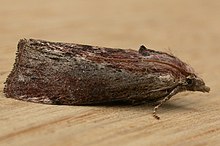
The Pyralidae, commonly called pyralid moths, snout moths or grass moths, are a family of Lepidoptera in the ditrysian superfamily Pyraloidea. In many classifications, the grass moths (Crambidae) are included in the Pyralidae as a subfamily, making the combined group one of the largest families in the Lepidoptera. The latest review by Eugene G. Munroe and Maria Alma Solis retain the Crambidae as a full family of Pyraloidea.

Waxworms are the caterpillar larvae of wax moths, which belong to the family Pyralidae. Two closely related species are commercially bred – the lesser wax moth and the greater wax moth. They belong to the tribe Galleriini in the snout moth subfamily Galleriinae. Another species whose larvae share that name is the Indian mealmoth, though this species is not available commercially.

The Pyraloidea are a moth superfamily containing about 16,000 described species worldwide, and probably at least as many more remain to be described. They are generally fairly small moths, and as such, they have been traditionally associated with the paraphyletic Microlepidoptera.

The lesser wax moth is a small moth of the snout moth family (Pyralidae) that belongs to the subfamily Galleriinae. The species was first described by Johan Christian Fabricius in 1794. Adults are about 0.5 inches (13 mm) in length and have a distinct yellow head with a silver-grey or beige body. Lesser wax moths are common in most parts of the world, except in areas with cold climates. Their geographic spread was aided by humans who inadvertently introduced them to many regions worldwide.
Émile Louis Ragonot was a French entomologist. In 1885, he became president of the Société entomologique de France.
Elwood Curtin Zimmerman was an American entomologist best known for his two multivolume series: Insects of Hawaii published by the University of Hawaiʻi Press and Australian Weevils published by Australia's CSIRO.

Aphomia sociella, also known as the bee moth and the bumble bee wax moth, is a small moth of the family Pyralidae and subfamily Galleriinae. Its body and forewings are typically reddish brown, tan, or dark green in color and females have a dark spot in the center of each forewing. The bee moth is native to Europe and are named "bee moths" because they seek out nests of bees and wasps to lay their eggs. Aphomiasociella are considered a pest because the bee moth larvae severely damage commercial bee hives. Bee moths are also studied for their unique mating ritual which includes a release of pheromones from both the male and the female along with an ultrasonic signal emitted through the male's tymbals.
The Insects of Hawaii series, now under the editorship of James K. Liebherr of Cornell University, aims to provide a collaborative, comprehensive, taxonomy of all known Hawaiian insect fauna. So far, more than 5,000 native arthropod species have been described. Only vols. 1, 16, and 17 are still in print, but the out-of-print volumes are being scanned and added to the University of Hawaii's digital repository.

Achroia is a genus of small moths of the snout moth family (Pyralidae). It belongs to the tribe Galleriini of subfamily Galleriinae.

Aphomia terrenella, the terrenella bee moth, is a moth of the family Pyralidae. It is found in North America from Michigan, Ontario, Quebec and New York south to Georgia.

The Galleriinae are a subfamily of snout moths and occur essentially worldwide, in some cases aided by involuntary introduction by humans. This subfamily includes the wax moths, whose caterpillars (waxworms) are bred on a commercial scale as food for pets and as fishing bait; in the wild, these and other species of Galleriinae may also be harmful to humans as pests.
Acracona is a genus of snout moths in the subfamily Galleriinae. It was described by Ferdinand Karsch in 1900, and is known from Uganda French Guinea, Togo and Madagascar.
Acyperas is a genus of snout moths in the subfamily Galleriinae. It was described by George Hampson in 1901 and is known from Papua New Guinea and Java, Indonesia.
Aphomia fulminalis is a species of snout moth in the genus Aphomia. It was described by Zeller in 1872, and is known from the United States, where it has been recorded from Arizona, Connecticut, Illinois, Massachusetts, Maryland, Maine, Mississippi, New York, Pennsylvania, Texas and Nova Scotia.

Aphomia sabella, the greater date moth, is a species of snout moth in the genus Aphomia. It was described by George Hampson in 1901 and is known from the Persian Gulf, Algeria and Iran. It was first recorded in Spain in 1999.
Cathayia obliquella is a species of snout moth in the genus Cathayia. It was described by George Hampson in 1901 and is known from Japan and central China.
Mampava bipunctella, the foxtail millet webworm, is a species of snout moth, and the type species in the genus Mampava. It was described by Émile Louis Ragonot in 1888, and is known from India, Papua New Guinea, Malaysia (Sarawak), Taiwan, China, the Moluccas, Indonesia and Japan.
Jinshichi Shibuya was a Japanese entomologist specialized in Lepidoptera.

Euzophera perticella is a species of snout moth in the genus Euzophera.







